第一讲 名词和冠词
- 格式:doc
- 大小:329.00 KB
- 文档页数:8
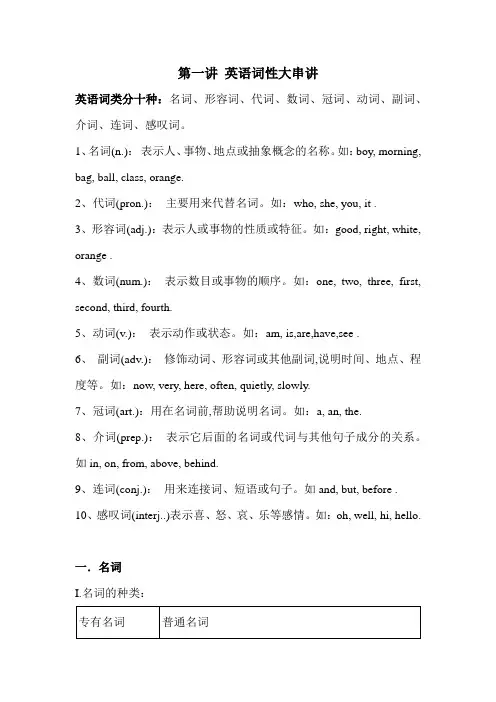
第一讲英语词性大串讲英语词类分十种:名词、形容词、代词、数词、冠词、动词、副词、介词、连词、感叹词。
1、名词(n.):表示人、事物、地点或抽象概念的名称。
如:boy, morning, bag, ball, class, orange.2、代词(pron.):主要用来代替名词。
如:who, she, you, it .3、形容词(adj.):表示人或事物的性质或特征。
如:good, right, white, orange .4、数词(num.):表示数目或事物的顺序。
如:one, two, three, first, second, third, fourth.5、动词(v.):表示动作或状态。
如:am, is,are,have,see .6、副词(adv.):修饰动词、形容词或其他副词,说明时间、地点、程度等。
如:now, very, here, often, quietly, slowly.7、冠词(art.):用在名词前,帮助说明名词。
如:a, an, the.8、介词(prep.):表示它后面的名词或代词与其他句子成分的关系。
如in, on, from, above, behind.9、连词(conj.):用来连接词、短语或句子。
如and, but, before .10、感叹词(interj..)表示喜、怒、哀、乐等感情。
如:oh, well, hi, hello.一.名词I.名词的种类:以练促记:1. ( 2012天津,32) —Why didn’t Sally play the violin at the concert last night?—She said that her hand hurt, but that was only a(n)_________. I saw her play tennis just now.A. matterB. excuseC. resultD. expression2. (2012重庆,24) —Bill ,what’s your sister’s favorite__________? —She likes volleyball best.A. foodB. colorC. sportD. movie3. ( 2012黑龙江哈尔滨,21 ) Dear friends ,please read every sentence carefully. Details decide __________ or not. If you take it serious-ly, you’ll achieve your goal!A. successB. successfulC. succeed4. ( 2012辽宁沈阳,8 ) The__________in that restaurant looks delicious ,but it tastes bad.A. cookB. tableC. foodD. tool5. (2012江苏南京,3 ) —Could you tell me how to remember new words quickly?—Yes, I think a__________ tree can help you a lot.A. grammarB. equationC. punctuationD. vocabulary6. ( 2012四川成都,33) —Where did you go yesterday, Rick?—I went to see a__________ because I had a cold.A. teacherB. doctorC. reporter7. ( 2012湖北武汉,33)lf by any chance Peter comes to us, please ask him to leave a__________.A. letterB. sentenceC. messageD. notice8. ( 2012浙江温州,5) —Where does your uncle work, Jack?—In a__________ in Paris. He is a policeman.A. TV stationB. bookstoreC. post officeD. police station9. ( 2012江西,27) If you go to visit London, don’t forget your __________ because it rains a lot.A.passportB.moneyC.mapD.umbrella10. ( 2012湖北襄阳,26) —What does your father do ,Lily?—He is __________ . His job is to make sure that drivers obey the traffic rules.A. an actorB. a policemanC. a waiterD. a reporterII. 名词的数:1. 规则名词的复数形式:名词的复数形式,一般在单数形式后面加-s 或-es。
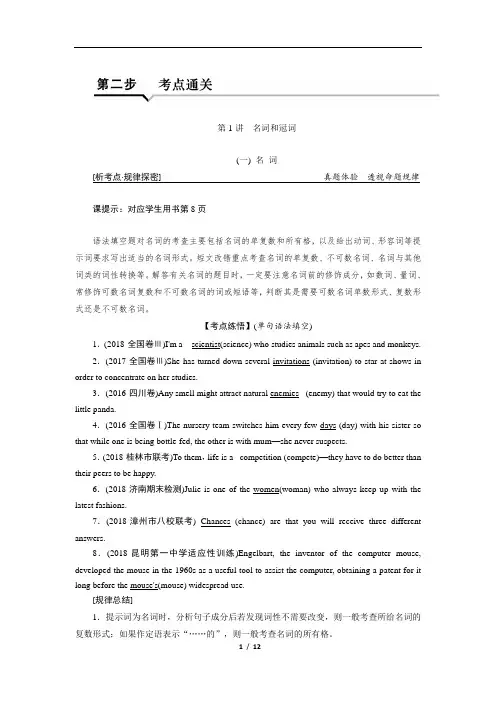
第1讲名词和冠词(一) 名词[析考点·规律探密]真题体验透视命题规律课提示:对应学生用书第8页语法填空题对名词的考查主要包括名词的单复数和所有格,以及给出动词、形容词等提示词要求写出适当的名词形式。
短文改错重点考查名词的单复数、不可数名词、名词与其他词类的词性转换等。
解答有关名词的题目时,一定要注意名词前的修饰成分,如数词、量词、常修饰可数名词复数和不可数名词的词或短语等,判断其是需要可数名词单数形式、复数形式还是不可数名词。
【考点练悟】(单句语法填空)1.(2018·全国卷Ⅲ)I'm a scientist(science) who studies animals such as apes and monkeys.2.(2017·全国卷Ⅲ)She has turned down several invitations (invitation) to star at shows in order to concentrate on her studies.3.(2016·四川卷)Any smell might attract natural enemies_ (enemy) that would try to eat the little panda.4.(2016·全国卷Ⅰ)The nursery team switches him every few days (day) with his sister so that while one is being bottle-fed, the other is with mum—she never suspects.5.(2018·桂林市联考)To them,life is a _competition (compete)—they have to do better than their peers to be happy.6.(2018·济南期末检测)Julie is one of the women(woman) who always keep up with the latest fashions.7.(2018·漳州市八校联考) Chances (chance) are that you will receive three different answers.8.(2018·昆明第一中学适应性训练)Engelbart, the inventor of the computer mouse, developed the mouse in the 1960s as a useful tool to assist the computer, obtaining a patent for it long before the mouse's(mouse) widespread use.[规律总结]1.提示词为名词时,分析句子成分后若发现词性不需要改变,则一般考查所给名词的复数形式;如果作定语表示“……的”,则一般考查名词的所有格。
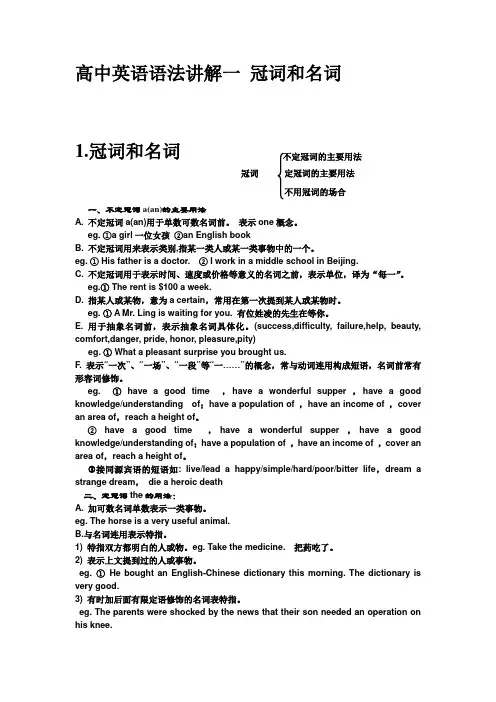
高中英语语法讲解一 冠词和名词1.冠词和名词一、不定冠词a(an)的主要用法A. 不定冠词a(an)用于单数可数名词前。
表示one 概念。
eg. ①a girl 一位女孩 ②an English bookB. 不定冠词用来表示类别,指某一类人或某一类事物中的一个。
eg. ① His father is a doctor. ② I work in a middle school in Beijing.C. 不定冠词用于表示时间、速度或价格等意义的名词之前,表示单位,译为“每一”。
eg.① The rent is $100 a week.D. 指某人或某物,意为a certain ,常用在第一次提到某人或某物时。
eg. ① A Mr. Ling is waiting for you. 有位姓凌的先生在等你。
E. 用于抽象名词前,表示抽象名词具体化。
(success,difficulty, failure,help, beauty, comfort,danger, pride, honor, pleasure,pity)eg. ① What a pleasant surprise you brought us. F. 表示“一次”、“一场”、“一段”等“一……”的概念,常与动词连用构成短语,名词前常有形容词修饰。
eg. ① have a good time ,have a wonderful supper ,have a good knowledge/understanding of ;have a population of ,have an income of ,cover an area of ,reach a height of 。
② have a good time ,have a wonderful supper ,have a good knowledge/understanding of ;have a population of ,have an income of ,cover an area of ,reach a height of 。
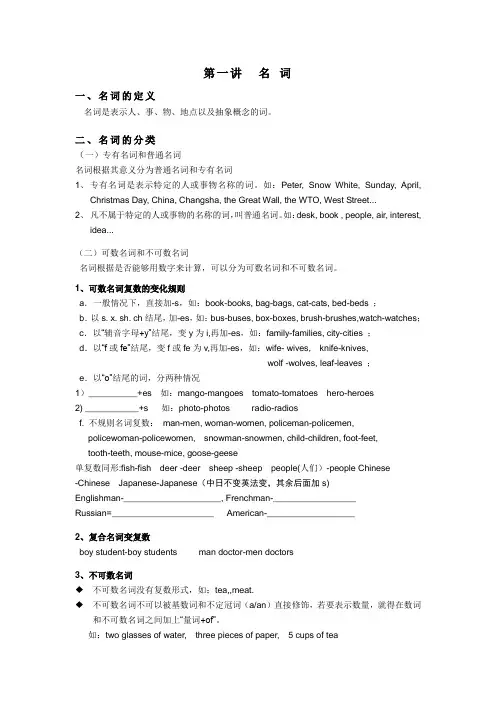
第一讲名词一、名词的定义名词是表示人、事、物、地点以及抽象概念的词。
二、名词的分类(一)专有名词和普通名词名词根据其意义分为普通名词和专有名词1、专有名词是表示特定的人或事物名称的词。
如:Peter, Snow White, Sunday, April,Christmas Day, China, Changsha, the Great Wall, the WTO, West Street...2、凡不属于特定的人或事物的名称的词,叫普通名词。
如:desk, book , people, air, interest,idea...(二)可数名词和不可数名词名词根据是否能够用数字来计算,可以分为可数名词和不可数名词。
1、可数名词复数的变化规则a.一般情况下,直接加-s,如:book-books, bag-bags, cat-cats, bed-beds ;b.以s. x. sh. ch结尾,加-es,如:bus-buses, box-boxes, brush-brushes,watch-watches;c.以“辅音字母+y”结尾,变y为i,再加-es,如:family-families, city-cities ;d.以“f或fe”结尾,变f或fe为v,再加-es,如:wife- wives, knife-knives,wolf -wolves, leaf-leaves ;e.以“o”结尾的词,分两种情况1)__________+es 如:mango-mangoes tomato-tomatoes hero-heroes2) ___________+s 如:photo-photos radio-radiosf. 不规则名词复数:man-men, woman-women, policeman-policemen,policewoman-policewomen, snowman-snowmen, child-children, foot-feet,tooth-teeth, mouse-mice, goose-geese单复数同形:fish-fish deer -deer sheep -sheep people(人们)-people Chinese-Chinese Japanese-Japanese(中日不变英法变,其余后面加s)Englishman-____________________, Frenchman-_________________Russian=_____________________ American-__________________2、复合名词变复数boy student-boy students man doctor-men doctors3、不可数名词◆不可数名词没有复数形式,如:tea,,meat.◆不可数名词不可以被基数词和不定冠词(a/an)直接修饰,若要表示数量,就得在数词和不可数名词之间加上“量词+of”。
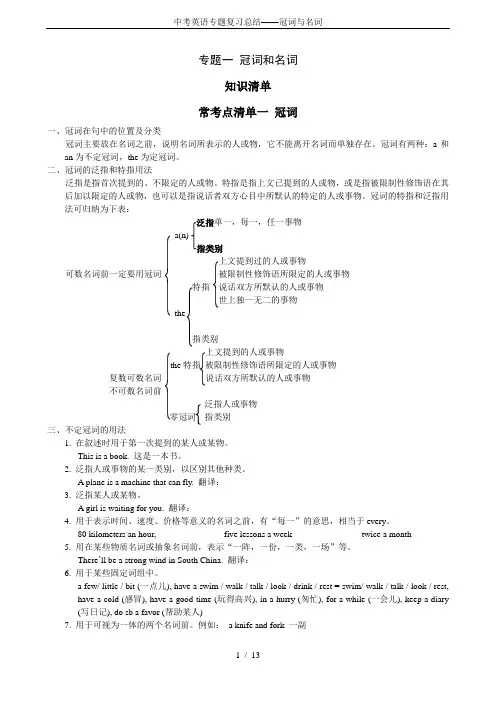
专题一冠词和名词知识清单常考点清单一冠词一、冠词在句中的位置及分类冠词主要放在名词之前,说明名词所表示的人或物,它不能离开名词而单独存在。
冠词有两种:a和an为不定冠词,the为定冠词。
二、冠词的泛指和特指用法泛指是指首次提到的、不限定的人或物。
特指是指上文已提到的人或物,或是指被限制性修饰语在其后加以限定的人或物,也可以是指说话者双方心目中所默认的特定的人或事物。
冠词的特指和泛指用法可归纳为下表:单一,每一,任一事物a(n)上文提到过的人或事物可数名词前一定要用冠词被限制性修饰语所限定的人或事物特指说话双方所默认的人或事物世上独一无二的事物the指类别the特指被限制性修饰语所限定的人或事物复数可数名词说话双方所默认的人或事物不可数名词前泛指人或事物零冠词指类别三、不定冠词的用法1. 在叙述时用于第一次提到的某人或某物。
This is a book. 这是一本书。
2. 泛指人或事物的某一类别,以区别其他种类。
A plane is a machine that can fly. 翻译:___3. 泛指某人或某物。
A girl is waiting for you. 翻译:___4. 用于表示时间、速度、价格等意义的名词之前,有“每一”的意思,相当于every。
80 kilometers an hour,_______________ five lessons a week _______________ twice a month____5. 用在某些物质名词或抽象名词前,表示“一阵,一份,一类,一场”等。
There’ll be a strong wind in South China. 翻译:___6. 用于某些固定词组中。
a few/ little / bit (一点儿), have a swim / walk / talk / look / drink / rest = swim/ walk / talk / look / rest,have a cold (感冒), have a good time (玩得高兴), in a hurry (匆忙), for a while (一会儿), keep a diary (写日记), do sb a favor (帮助某人)7. 用于可视为一体的两个名词前。
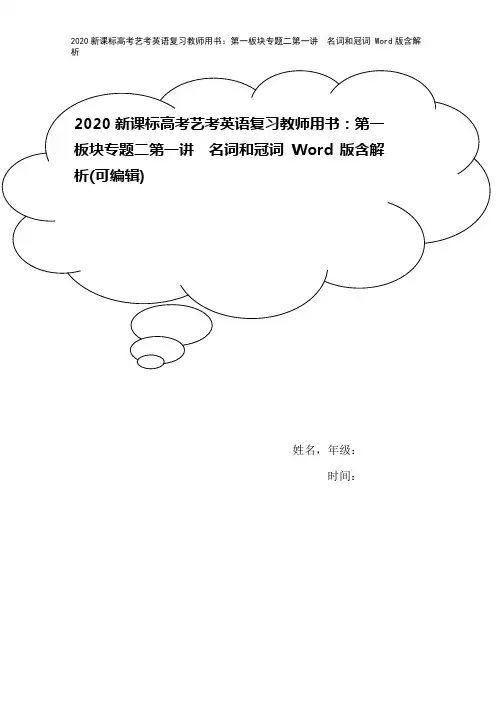
姓名,年级:时间:第一讲名词和冠词语法项目(一)名词语法填空题对名词的考查主要包括名词的单复数和所有格,以及给出动词、形容词等提示词要求写出适当的名词形式。
短文改错重点考查名词的单复数、不可数名词、名词与其他词类的词性转化等.解答有关名词的题目时,一定要注意名词前的修饰成分,如数词、量词、常修饰可数名词复数和不可数名词的词或短语等,来判断其是需要可数名词单数形式、复数形式还是不可数名词;有的还要结合语境分析句子成分,来判断是否需要作主语、宾语、表语或定语的名词。
如何确定填单复数、所有格还是派生为名词[思考趋向]1.填名词的单复数若提示词是名词,分析句子成分后发现词性不需要改变,此时应考虑填名词的单复数。
2.填名词的所有格提示词为名词时,如果作定语表示“……的",则一般考查名词的所有格。
3.派生为名词[典例感悟][典例1](2017·全国卷Ⅲ)She has turned down several ________ (invitation) to star at shows in order to concentrate on her studies.解析:invitations invitation“邀请”是可数名词,其前有several修饰,应用复数形式。
[典例2](2019·湖南师大附中模拟)This could be ________ (Mary)motto——the expression that best captures her spirit.解析:Mary's 此题考查名词的所有格,根据语境应该表示“玛丽的格言”。
[典例3](2017·浙江卷11月)Of course you have to work at it。
You wouldn't think that a few ________ (month) of exercise in your teens would be enough for the rest of your life,and that's also true for building your vocabulary—you have to keep at it daily,and pretty soon you will find that you have an excellent vocabulary。

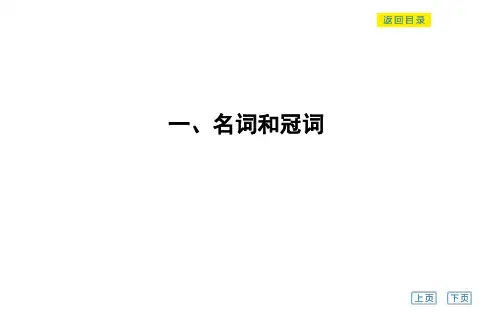
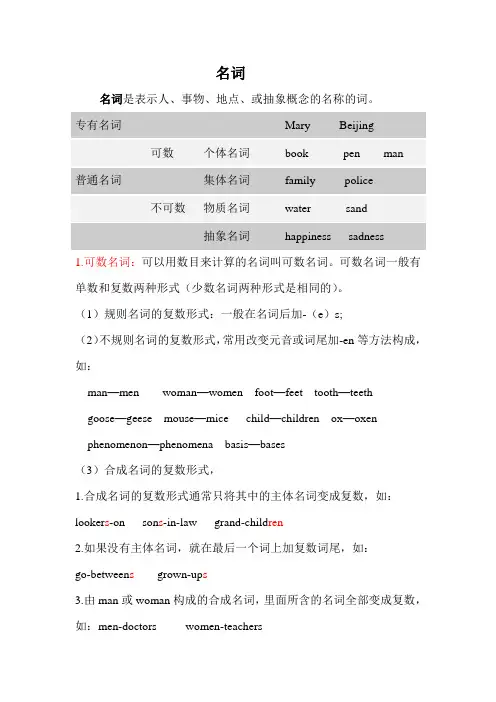
名词名词是表示人、事物、地点、或抽象概念的名称的词。
专有名词Mary Beijing可数个体名词book pen man普通名词集体名词family police不可数物质名词water sand抽象名词happiness sadness1.可数名词:可以用数目来计算的名词叫可数名词。
可数名词一般有单数和复数两种形式(少数名词两种形式是相同的)。
(1)规则名词的复数形式:一般在名词后加-(e)s;(2)不规则名词的复数形式,常用改变元音或词尾加-en等方法构成,如:man—men woman—women foot—feet tooth—teeth goose—geese mouse—mice child—children ox—oxen phenomenon—phenomena basis—bases(3)合成名词的复数形式,1.合成名词的复数形式通常只将其中的主体名词变成复数,如:looker s-on son s-in-law grand-child ren2.如果没有主体名词,就在最后一个词上加复数词尾,如:go-between s grown-up s3.由man或woman构成的合成名词,里面所含的名词全部变成复数,如:men-doctors women-teachers(4)有些名词单复数形式相同,如:means方法,series系列,fish鱼,sheep羊,deer鹿,Chinese 中国人,以及其他以ese结尾的表示某国人的词等。
(5)有些名词通常只有复数形式,如:scissors clothes trousers shorts(6)有些名词的复数有两个意思,一个与单数的意思相似,另一个则与单数的意思不同,如:arm手臂——arms 手臂,武器colour 颜色——colours 颜色,旗帜(7)一些名词是单数形式,却用作复数,如:Several hundred police were on duty.2.不可数名词:一般不可以以用数目来计算的名词叫不可数名词。
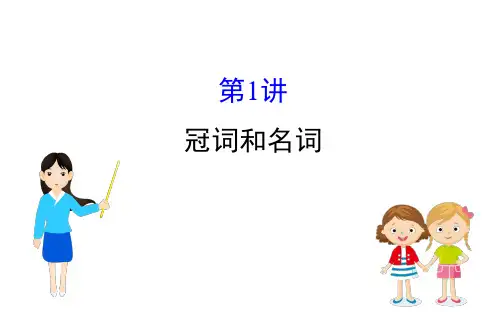
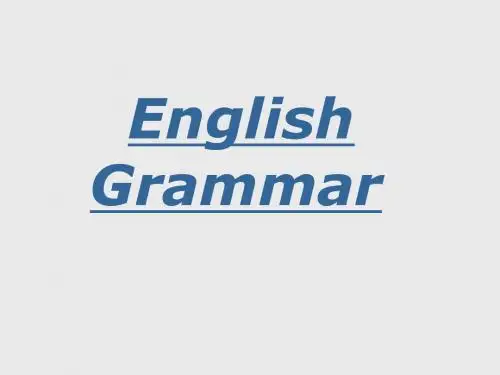
高中英语语法系统讲解之一名词和冠词名词一. 名词的分类1. 普通名词:○1个体名词,如man,woman,desk,pencil 一般可数,○2集体名词,如class,family,police,army 有单、复数形式。
○3物质名词,如meat,rice,cotton,iron 一般不可数,○4抽象名词,如life,help,happiness,sadness 没有单、复数之分。
2. 专有名词,如England,Shanghai,London,Smith,Karl Marx二. 名词的数1. 可数名词单复数变化形式可数名词是表示可以计数的人、事物的名词。
可数名词一般有单数和复数两种形式,有些词单复数形式相同。
单数变复数有规则变化和不规则变化两种。
○1规则变化A. 单数名词词尾直接加-s。
如bo y—boys,pe n—pens。
B.以s,x,ch,sh结尾的词一般加-es。
如glas s—glasses,bo x—boxes,watch—watches。
C. 以“辅音字母+ y”结尾的词变y为i再加-es。
如baby—babies,lady—ladies。
D.以o结尾的词有些加-es。
如tomato—tomatoes,potato—potatoes,hero—heroes。
以“元音+ o”或“oo”结尾的词和一些以“o”结尾的外来词只加-s。
如radi o—radios,zoo—zoos,photo—photos,piano—pianos,kilo—kilos,tobacco—tobaccos。
E. 以f或fe结尾的词,多数变f或fe为v,再加-es。
如wif e—wives,life—lives,knife—knives,wolf—wolves,self—selves,leaf—leaves。
特例:handkerchie f—handkerchiefs或handkerchives,roof—roofs,chief—chiefs,gulf—gulfs,belief—beliefs,cliff—cliffs。
第一层级|抓牢“词法”——保基本分第一讲名词和冠词在高考中,语法填空和短文改错重点考查名词的单复数、不可数名词、名词与其他词类的词性转化等。
在语法填空和短文改错中,解答有关名词的题目时,一要根据在句中所作的成分确定是否使用名词。
名词在句中常用作主语、宾语、表语或定语等。
二要根据名词前的数词、量词、冠词等修饰语的情况以及主谓一致原则来确定名词单复数。
(一)考点练悟(用所给词的适当形式填空)It was late at night. Two 1.________ (German) were sleeping i n their room when suddenly, one of them, Mrs. Green, was w oken up and found a thief slipping into their room to try his luc k. She had three thousand 2.______ (dollar) in her pocket. “W hat should I do? Many 3.______ (thief) usually bring 4._______ _ (knife) with them,” she thought in 5.________ (silent). After two 6.________ (minute) search, the thief happened to touch a sports suit. It seemed as if he found there was someone in th e room, so he went out to the next room where two 7.________ (Frenchman) were sleeping. When he was looking for 8.___ _____ (money) or some 9.________ (jewel) in the next room, Mrs. Green woke up her husband quickly and called the polic e. And then the thief knew what had happened. He was so sc ared that he took out a knife. Just then the police showed up. Before the thief ran away, the police caught him. For Mrs. Gre en, it was really an unusual 10.________ (experience).答案:1.Germans 2.dollars 3.thieves 4.knives 5.silence 6.minutes' 7.Frenchmen 8.money 9.jewels/jewelry10.experience(二)快捷技法(三)重点强化1.可数名词复数的规则变化:(1)一般情况下在词尾直接加s(2)以s, x, ch, sh结尾的名词,在词尾加es(3)以辅音字母加y结尾的名词,将y变为i,再加es(4)以元音字母加y结尾的名词,在词尾直接加s(5)以o结尾的名词,无生命的常在词尾加s,如pianos, photos;有生命的在词尾加es,如potatoes, heroes等(6)以f或fe结尾的名词,多数变f或fe为v,再加es。
专题一名词和冠词(一)名词知识点一名词的数1.可数名词单数变复数的规则(1)一般在名词词尾直接加s。
friend朋友→friends nation国家→nations interest兴趣→interestschange变化→changesmember成员→memberspainting油画→paintings(2)词尾是s,x,ch,sh时一般加es。
bus公共汽车→buses fox狐狸→foxes coach教练→coaches bush灌木丛→bushes 注意:stomach(胃部)等词的复数形式是在词尾直接加s。
(3)词尾是辅音字母+y时,变y为i再加es。
enemy敌人→enemies hobby业余爱好→hobbies difficulty困难→difficulties 词尾是元音字母+y时,直接加s。
guy家伙→guys key钥匙→keys(4)词尾是f或fe时,多将f或fe变为ves。
shelf架子→shelves knife刀子→knives wolf狼→wolves calf牛犊→calves housewife家庭主妇→housewives(5)词尾是o的名词,有些直接加s,有些加es。
bamboo竹子→bamboos tomato番茄→tomatoes potato土豆→potatoes实录:名词可以在句子中作主语、宾语、表语、补语、定语、状语、同位语以及称呼语,但不能作谓语。
记法:规则变化名词单数变复数,直接加-s占多数;s,x,z,ch,sh来结尾,直接加上-es;词尾是f或fe,加-s之前先变ve;辅母+y在词尾,把y变i再加-es;词尾字母若是o,常用三个已足够,要加-es请记好,hero, tomato, potato。
2.常用特殊名词的复数形式(1)单复数同形的名词sheep绵羊deer鹿aircraft飞行器Chinese中国人Japanese日本人means手段works工厂series系列(2)自身有特殊变化的名词child孩子→childrenman男人→men woman女人→womentooth牙→teet hfoot脚;英尺→feetmouse老鼠→micecriterion标准→criteriaphenomenon现象→phenomenamedium传播媒介→media(3)合成名词的复数变化规则①有中心名词的合成词的复数,是在中心名词后加-s。
一、名词(一)名词的定义名词是表示人、食物、地方、现象及其他抽象概念的词。
名词可分为专有名词和普通名词。
(二)可数名词和不可数名词名词按其所表示的食物性质可分为可数名词和不可数名词。
1.不可数名词——不可数名词没有反复数形式。
如:water, some milk, some bread.2.可数名词——可数名词分为单数和复数两种形式。
如:a girl, some girls可数名词的单数就是该词本身,在句中试用时,在其前加a或an。
注意:a 用于以辅音音素(指音标)开头的单数名词前,an用于以元音音素(指音标)开头的单数名词前。
如:book, an English book, an apple,a red apple, a man, an old man. (二)名词的数(1)元音发生变化如:man, men, woman, women, tooth, teeth, foot,feet, goose, geese, mouse,mice(2) 词尾发生变化Child children(3) 单复数形式相同如:fish, sheep,deer, Chinese, yuan,jin注意:作鱼肉讲时不可数,没有复数。
有时也可用指各种不同种类的鱼,如果指一种鱼时,单复数相同。
(4)形似单数,实为复数如:people(人,人们),可以说some people,但不能说a person(要表示“一个人”可用a person).Police(公安,警察),指的是“警察”的统称,要说“一名警察”要用 a policeman/policewomen.5) 由man 和woman构成的合成词,其复数形式也是-men,-women如如frenchmen,englishmen,,还有起修饰作用的,woman doctor---women doctor(女医生) 但是其他合成词,只需把合成名词中的中心词变为复数形式。
如:Banana tress----------banana trees 香蕉树(6)只用作单数,但以复数形式出现的名词有:maths physics, the United States, 等3.物质名词的定量表示方法不可数名词的定量表示不可数名词一般不可以直接被基数词修饰。
英语语法知识:名词、代词和冠词1. 名词:表示人或事物的名称的词叫名词。
名词在句子中可以作主语,宾语,表语,宾语补足语,定语,名数词连用可以做状语。
在使用名词时,要注意区分可数名词和不可数名词,以便于正确使用表示不确定数量的定语。
如:a lot of / plenty of / some 可以修饰可数名词和不可数名词。
而:many, a few, few several, scores of, large quantities of, dozens of, a couple of 等只能用在可数名词之前,much, a great deal of, a little, little, a great amount of 等只能用在不可数名词之前。
2. 冠词:冠词是一种虚词,放在名词前面,帮助说明名词的意义。
冠词有不定冠词和定冠词两种。
a (an)是不定冠词,an用在元音发音开始的词语前。
如:an hour, an English book。
the 是定冠词。
1)不定冠词:不定冠词a (an)只能用在单数可数名词前。
关于它的用法,用四个字概括,“每、一、类、某”。
①表示“每日”、“每周”……Please take this medicine three times a day.②表示某一种人或物中的一个。
All of us know that he is a teacher, not a student.③表示某一类人或物。
It is an easy task for an elephant.④表示“某一个”,但仍译为“一个”、“有个”。
One day, a Frenchman went to Berlin on business.2)定冠词的用法:①特指某人或某物,指说话人与听话人都知道的人或物。
Look at the picture. Is there a man in the picture?②复指前面已提到的人或物。